Affiliate disclosure: This post may contain affiliate links. Please see our Privacy Policy.
Ashwagandha plants aren’t something you generally find outside of India and Nepal, but they’ll grow easily in a backyard garden. Also known as Indian ginseng, it’s a potent medicinal in the Ayurvedic tradition. It’s said to impart the strength and vitality of a stallion, and western herbalists know it as an adaptogen that can be used for many different conditions.
The Ashwagandha herb can be expensive to buy, especially in supplement form, but it’s simple to grow and thrives with minimal care.
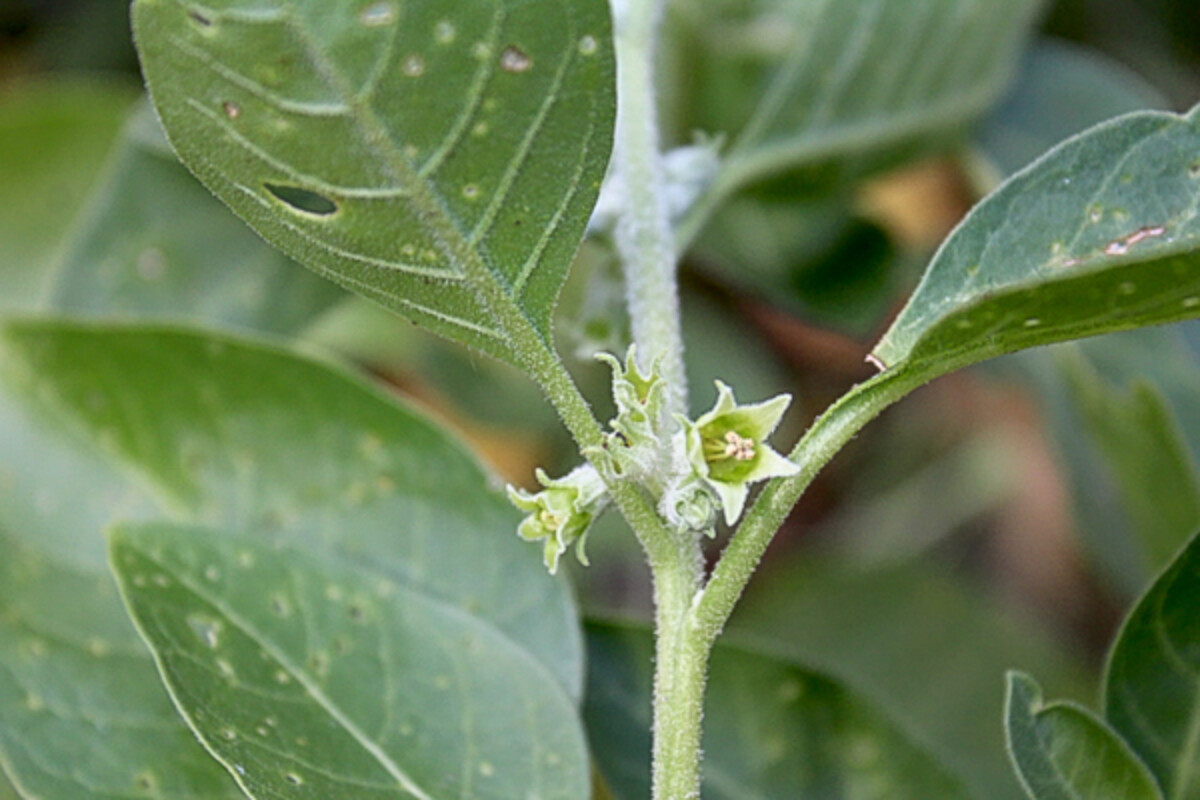
I was surprised to find an Ashwagandha seedling at our local nursery, but I’ve heard so much about the benefits of Ashwagandha that I couldn’t pass it up. I love the idea of growing vitality in my garden, and the simple act of growing keeps me young even if all the herbs in the world are nothing more than a placebo.
Like many gardeners excited at the nursery, I picked up a seedling with absolutely no idea how to grow it. Over the course of the summer, my tiny plant thrived even though it was mostly forgotten.
(It’s rare that you’d find them at your local nursery, and seeds are sometimes hard to find too. There is a small Vermont seed company that focuses on hard-to-find medicinal herbs and they have ashwagandha seed packets available.)
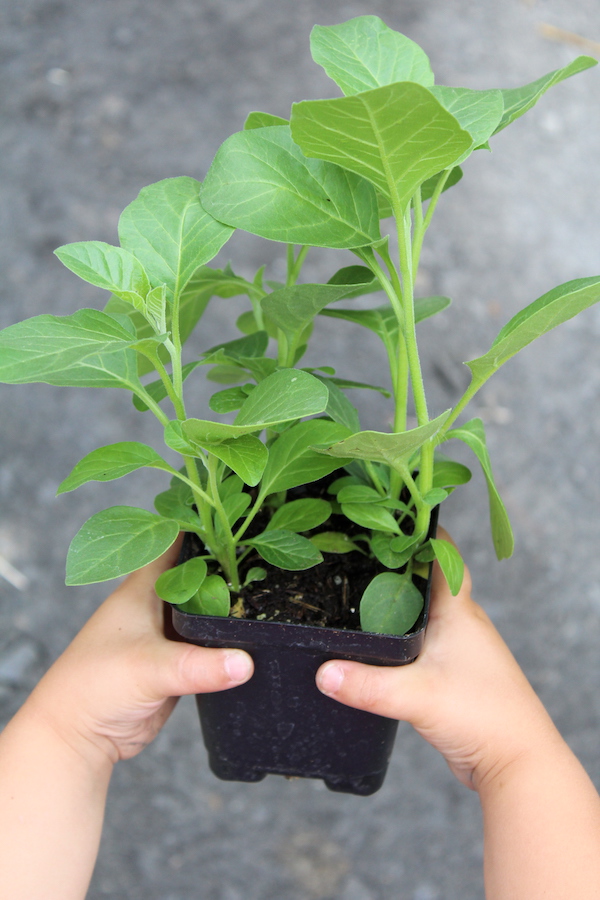
Growing Ashwagandha
The Ashwagandha plant is a perennial herb hardy to zone 6. I’m growing in a cold zone 4 with a 100 day growing season, which doesn’t exactly mimic the conditions found in India.
Nonetheless, I was able to grow Ashwagandha as an annual and harvest the medicinal roots before the first frost.
Every instruction I could find said that ashwagandha plants thrive in dry soil, and they’re extremely drought tolerant. The plants are generally started from seed in a soil that’s at least 70 degrees F.
The seeds take about 2 weeks to germinate, and after that, Ashwagandha plants need temperatures between 70 and 95 degrees for optimum growth.
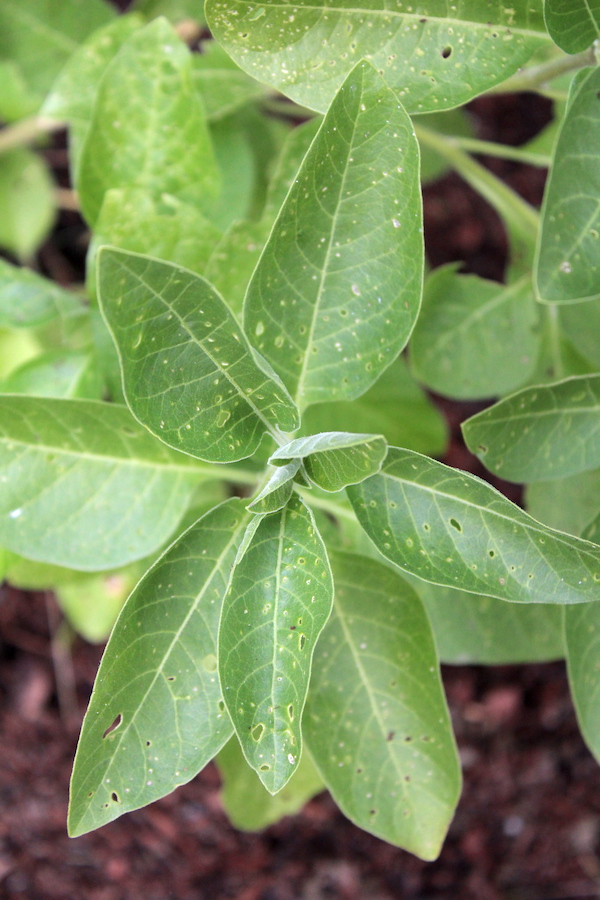
This summer was one of the hottest and dryest on record in Vermont, but it’s still rare to see a 90+ degree day. Dry is also a bit relative since a dry summer here still means 4 to 6 inches of rain per month.
Even with the relatively cool and wet conditions, my plant grew nicely. Plants generally reach around 3 feet tall, and mine was about 2 1/2 feet tall and flowering as the first frosts arrived in mid-October.
If allowed to mature fully, ashwagandha plants produce bright red fruit in a papery husk. They look somewhat similar to tomatillos or husk cherries, though they’re not related.
My plants only made it as far as flowering, but in a warmer climate with a longer growing season, they should fruit. I’ve read that the fruit generally matures once the plants are between 150 and 180 days old, which is much longer than our local growing season.
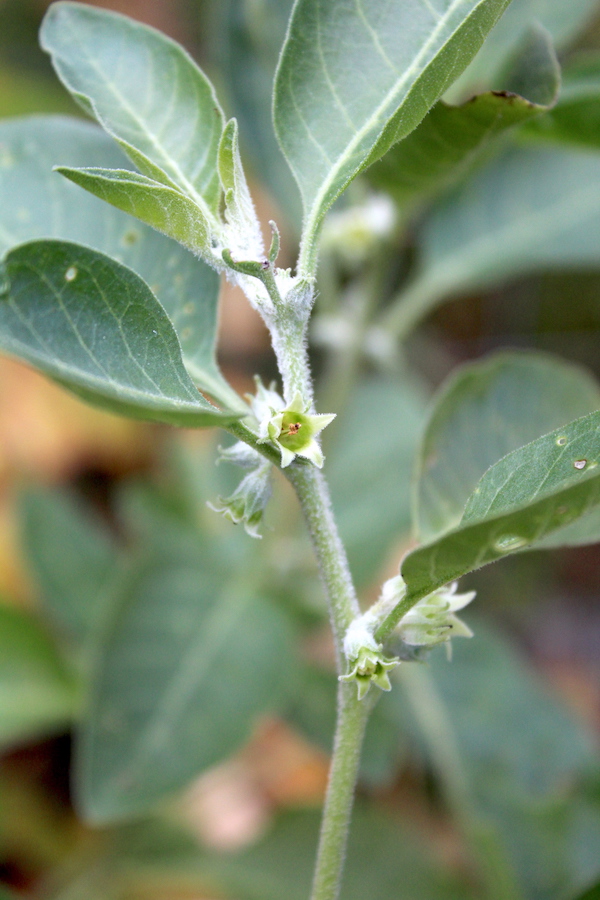
Harvesting Ashwagandha
In traditional ashwagandha propagation, the roots are harvested after the fruit have completely matured.
In colder climates, the whole plant can be potted up and overwintered indoors. If they’re kept at cool indoor temperatures, around 60 degrees, growth will slow over winter and they’ll be ready to resume once spring arrives.
Another option is simply harvesting the roots before the first frost. The harvest will be a bit smaller, but you’ll save the hassle of growing ashwagandha indoors.
Carefully dig each root and gently dust off the soil. Give them a quick wash and then dry them in a well-ventilated area with good airflow.
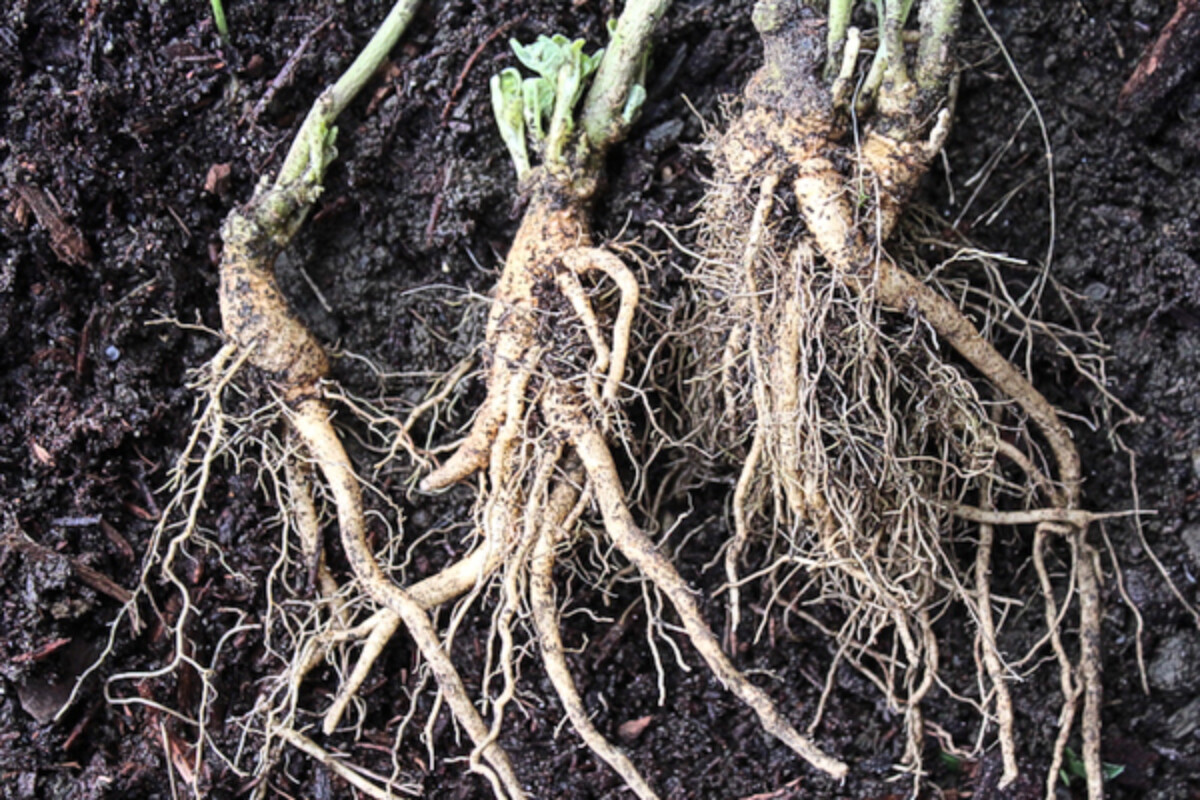
Since ashwagandha plants are generally grown in hot, dry conditions it may be difficult to effectively dry the roots in humid climates. We had a bit of trouble getting the roots to dry out thoroughly.
In that case, chop the roots and dry them in a dehydrator, or in the oven on the lowest setting.
How to Use Ashwagandha
Now that you have Ashwagandha, what on earth do you do with it? When I harvested the roots I was overwhelmed with how “medicinal” they smelled, and not in a pleasant way. The powdered roots are quite bitter, but that’s common with medicinals.
Traditionally, powdered ashwagandha root is mixed with honey and milk to help mask the taste. It’s also a common ingredient in “golden milk” which is basically a medical herbal chai that often incorporates turmeric, ginger and other health-boosting Indian herbs.
We make it at home with homegrown turmeric and ginger, but their benefits are more potent if they’re lacto-fermented. We ferment turmeric too, so it’s easy to make a 100% homegrown golden milk latte, which seems pretty magical up here in the frosen north.
Benefits of Ashwagandha
As an adaptogen and ginseng substitute, ashwagandha is appropriate for many conditions. Studies have shown that it can inhibit tumors in cancer patients and help improve memory for Alzheimer’s patients (source).
Traditionally, it’s used to promote general vitality regardless of the situation. Ashwagandha is given to weak or sickly children, adults seeking greater focus or concentration, and the elderly to forestall dementia.
Medicinal Herb Growing Guides
Looking for more medicinal plants to add to your garden?
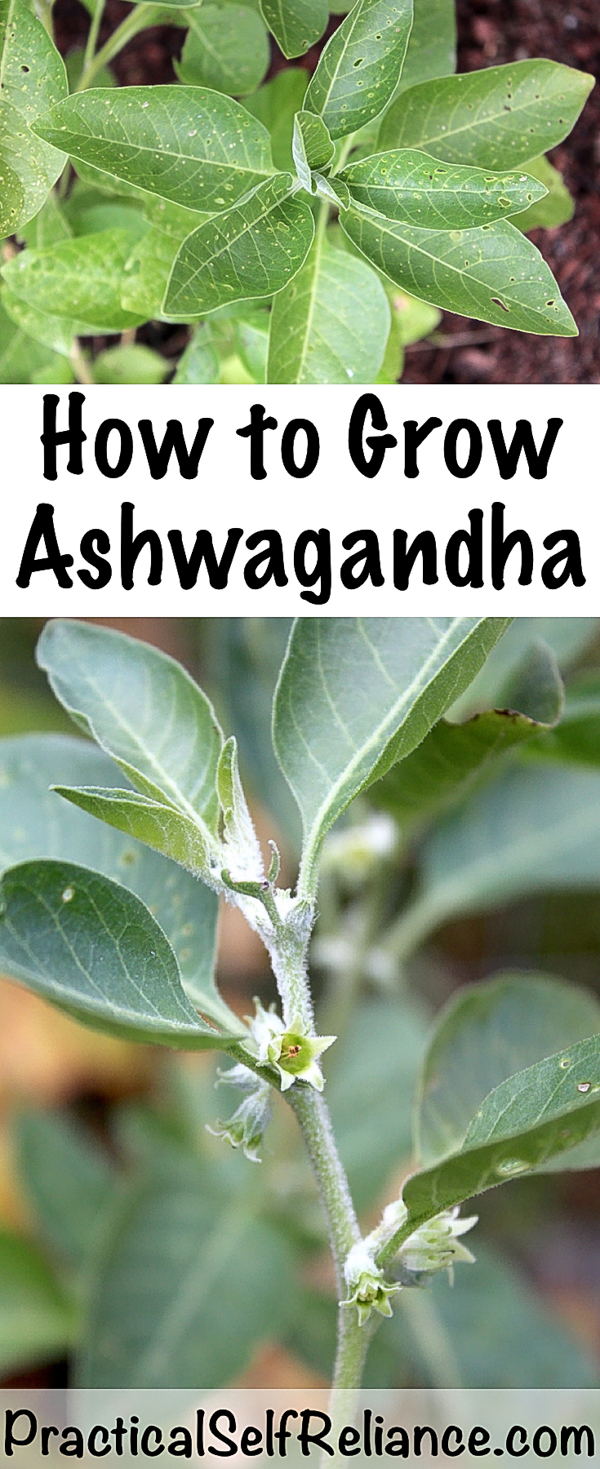
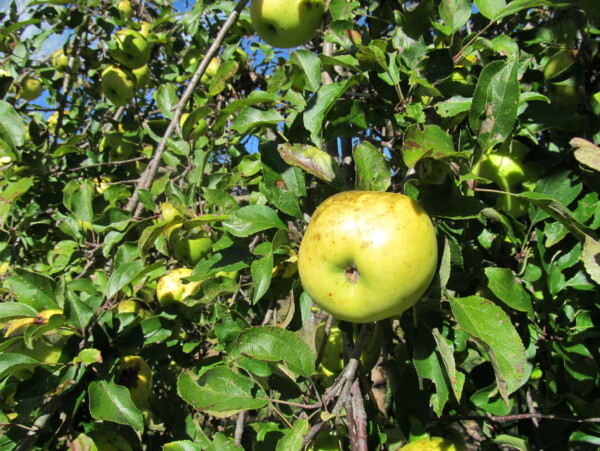













Are these plants self fertile or do I need another plant for pollination to start my own from seeds from my existing plant?
Good question! They’re generally considered to be self fertile and you only need one plant, but if you don’t have many bees around you may need to hand pollinate the flowers to get seed to set.
Thank you for all the information you share! You are one of my favorite resources
Can ashwaghanda be grown in a pot? Thanks!
Yes, it’ll grow in a pot, but the plants do get pretty big. Aim for 3 to 5 gallons for the pot, and use a sandy potting soil. I’d say go with 3/4 cactus potting mix, and 1/4 compost. It should be lighter and better draining than standard potting soil, but not all the way as sandy/dry as for cactus. Best of luck!
Do you think the roots could be made into a tincture? The many benefits of it could be used by my family. But, there is not way they would drink the milk, tea etc… But, I can get them to take tinctures. Thanks so much.
Yes definitely!
Just know that the tincture tastes awful and it is traditionally given with milk because ashwaganda active ingredients are fat soluble. I take with a shot glass of milk, then wash it down with something tasty.
How do I prepare the roots? Do they need to be peeled?
Also zone 4 here, survived several frosts, rest of garden died and still green and standing under snow,lol. Decided to harvest before ground freezes.
No, you don’t need to peel them. Just wash them, chop them and dehydrate them.
Thank you, this is my first time growing ashwaganda, zone 4 I washed the roots scrubbing between my fingers I turned the fresh roots into tincture by blending them in vodka and everclear. Had enough for two quarts. Is the starch inulin, part of active ingredient? Liquid that forms on top before I shake it is red/purple ,like st johns wort.
Are you asking about the inulin content in ashwagandha or the benefits of ashwagandha?
Mainly I wanted you to know how much you inspired me to try in zone 4, and it was suggessfull. Figured out since that the medicinal values are always in the starch, other plants too. Would be curious to know what nutritional or medicinal values are in the liquid portions after starch settles. I always shake them together before use.
I see yours in the pictures have tiny little holes in them and mine did the same thing, although I could never find any bugs eating on them. Do you happen to know what critter it is that eats on them and how to combat it? Thank you!!!
I’m not sure but personally, it isn’t really a concern for me since the root is what we’re after here anyway.
Hi there. I just wanted to say that ashwagandha is most definitely related to tomatillos and ground cherries. They are all in the solanaceae/nightshade family.
I grow ashwagandha on my sunny balcony in Sweden/Scandinavia.
The largest roots in autumn is repotted indors and kept in a sunny window where they grow until the spring.
Roots ar traditionally used, but the plants produce a lot of leaves that I let dry and make tea of.
I colect seeds from the largest plants with the largest roots, for sowing next year.
Good to know!
I appreciate your mention of using the leaves for tea! That is something I would like to try as I am in zone 4 in the US. It has been difficult finding info about the leaves.
Given one growing season, how much powder does the roots of a single plant yield? In other words, to use it medicinally, how many plants would you want growing at the same time to give you enough to last a year?
It’s hard to say. That depends on several factors. I did find this video that shows a root harvest that might give you an idea of how much to expect from a single plant. https://www.youtube.com/watch?v=L_kD-1iRUX8
Is Ashwagandha grown in full sun or can it grow in part shade? I am in zone 9.
It will grow best in full sun.
We grow ashwagandha here in northern Thailand. It takes a little longer to dry during the rainy season. The roots are the part that you want to use and yes they are bitter. Once they are dried, grind them up and I put the powder in capsules so I don’t have to taste it. It’s a fabulous adaptagen for a whole lot of things. I’ve been using it for years – long before it became popular. In order to assure that you are getting the best possible, I would definitely grow it yourself.
I live in Barbados, I purchased one Ashwagandha plant from MuddyBoots a plant nursery here.I have not planted it as yet because of the rains we are having, but I am looking forward to the progress it makes.
Hello. I can’t send seeds to you myself as I’m but I just checked and Strictly Medicinal Seeds online in the US have seeds in stock now. I had no problem growing Ashwaganda here, but I’m about zone 9-9B. I’m about to harvest the roots. 🙂 I had lots of fruit and have babies coming up in a pot that I just popped the semi dried berries into.. Oh, I believe that Ashwaganda is actually a cousin of tomatillos and tomatoes etc, being in the Solanaceae family, but I’ve read that the plant is inedible, so you dpn’t want to be eating those berries. .
Thanks for letting me know they’re in stock over at Strictly Medicinal Seeds and for your insight!
I bought my seeds from Strictly Medicinal Seeds online. I live in Arizona and right now (August) the plant is still very small (less than a foot tall). I grew it from seeds outside starting around May. We’ll see how much more it grows before the first frost and harvesting the roots. So far no flowers. I sure hope it works out.
How did it turn out?
It stayed very small but I went ahead and harvested what little roots I had from the plant and dried them. I’m going to try again this year. I’ve got some in the seed tray indoors right now under grow lights and heating mats. They haven’t germinated yet but I just planted them on March 5th. I will also try and plant some directly outside in May again this year.
Thank you!
Tracy
I am interested to see how they work out for you this year.
Thank you for the information, I will plant some and I am sure that here in Guadalajara, in spite of our altitude and cool “winters” that it will grow well. I will post results when I have some.
That sounds great! Looking forward to hearing how it goes.
I live in Norcal and just got my seeds should I start them in the house since its in the 90+ temps right now here? Also can they be pot grown? and are the roots the only medicinal part of the plants? what type of soil should I buy since the soil here it sand and rocky? Thanks Mark.
They just need a minimum soil temperature of 70 degrees to germinate. I would go ahead and plant them outside. Many people have had success growing them in pots. The roots are what is traditionally used medicinally. You should be able to use any kind of soil that you would typically use for growing other plants.
Are the red fruit new seeds? My plant is producing red fruit and I’m not sure what to do with them
The fruit from the Ashwagandha is not edible but that is where you will find the seeds.
Where can I find seeds for ashwagandha?
In USA?
Baker Creek Heirloom Seeds is my go to source for most of my seeds. Here’s a link to their
if it helps any, I purchased my ashwangha seeds from Baker Creek and my plants turned out great! I harvested the root last year and forgot about it in my garage. Am assuming it’s still ok to powder and eat?
I would say if it is still in root form then it should definitely still be good to powder. So glad your plants turned out so great.
Strictly Medicinal has a huge variety of seeds. They are a small family business. That’s where I get most of mine from and have always germinated.
Where can i purchase Ashwagandha? I live in northern Minnesota and have never seen it available around here.
I’m sorry, I don’t know what’s available in Minnesota. Have you looked for seeds online?
I just bought seeds from Mountain Rose herbs. $4.95 for 100 seeds. Can’t wait to try growing it.
Mountain Rose Herbs is now advertising for 50 seeds for $4.95. 🙁 Guess the word is getting out!
I ordered Ashwagandha plants from The Growers Exchange. They are doing extremely well here in southern Oklahoma. I believe The Growers Exchange is out of Virginia. http://www.thegrowers-exchange.com.
I am in MN as well. I had never seen it anywhere until I went to Two Harbors, MN and found a woman selling an unusual variety of 3 inch potted plants at the Two Harbors Farmers market. . I got Angelica and Borage from her also. The Ashwaganda grew very nicely but, just had to bring it in as the temps are getting cold at. I hope it will still produce berries so I can have some seeds.
You can take cuttings quite esasily.. I’m in the subtropics of Australia so Ashwaganda grows as easily as tomatoes do, but it acts as a short-lived perenial and sets seed almost as easily (mine do berry up every season!) but (conjecti=ure here on my part) I think the suggestion regarding the roots being harvested post-fruit development is possibly due to the more mature roots being more potent. Of course climate will disallow that full cycle in some areas, but if you take cuttings from an already almost mature plant then the new cutting-grown plants should already have that ‘age’, i think, and then it would simply be a matter of letting the roots gain physical size 🙂 And taking cuttings negates the need for seeds. 🙂
I am in Australia too, Victoria. Did you buy the seeds here or overseas. If you would share where you got them from I would be very grateful, Thank you
what do you do with the red berries? are those what you plant once you have dug up the plant for the roots? i am confused as to what other parts of the plant you use- the leaves, berries, or what- just the roots are beneficial? where are the seeds?
thank you
The seeds are inside the red berries, just squeeze them out and dry.
Thanks for the info! I live in north central Texas and I want to try growing Ashwagandha since I take the supplement. I have more confidence that I can do this.